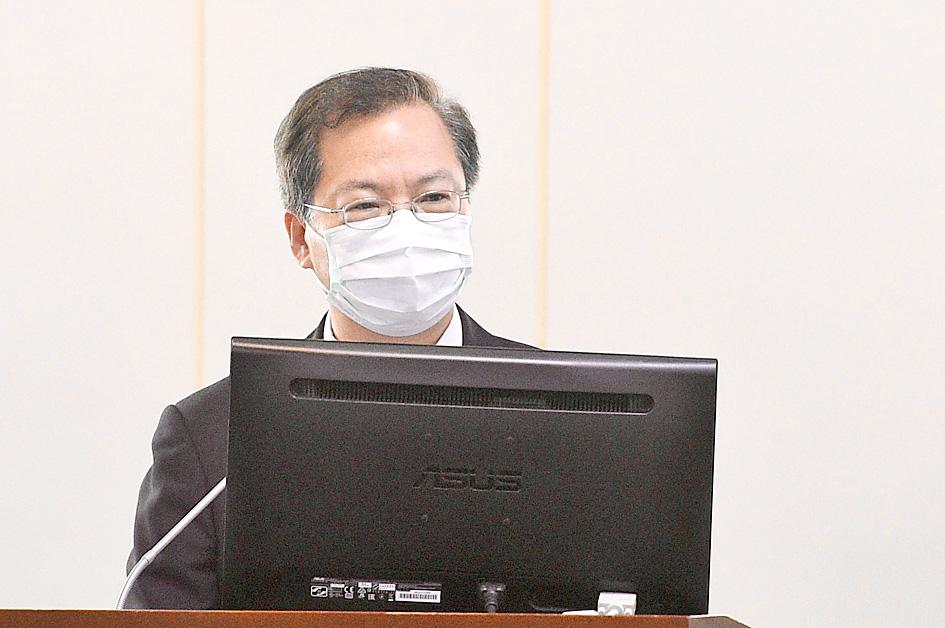Highly skilled blue-collar workers are being excluded from government attempts to attract foreign talent, lawmakers yesterday told a joint meeting of the legislature’s Economics Committee, Social Welfare and Environmental Hygiene Committee, and Education and Culture Committee.
Draft amendments to the Act for the Recruitment and Employment of Foreign Professionals (外國專業人才延攬及雇用法修正草案) seek to ease requirements for foreign white-collar employees who want to work in Taiwan, but in-demand blue-collar workers face much more onerous rules, Taiwan People’s Party Legislator Ann Kao (高虹安) said.
“There are many migrant workers who come to Taiwan to work in our tech factories on the production lines under the Employment Service Act (就業服務法),” Kao said. “They are highly skilled workers, yet they are limited to 12 to 14 years here before they have to leave Taiwan.”

Photo: George Tsorng, Taipei Times
By limiting the employment period of foreign blue-collar workers, Taiwan risks becoming a “training center,” leaving those workers, who could have otherwise made Taiwan their home, with no choice but to move to another country, Kao said.
“With the rising importance of technology in US-Taiwan-China relations, this is a national security issue,” she said.
National Development Council Minister Kung Ming-hsin (龔明鑫) said he agreed that blue-collar talent drain is “of grave concern to Taiwanese industry.”
“It is not an issue that is addressed in the draft amendments,” Kung said. “However, we are in talks with Vice Premier Shen Jong-chin (沈榮津) to deal with the problem separately.”
The talks are still in preliminary stages, he added.
Unlike blue-collar workers, “foreign special professionals” can stay in Taiwan indefinitely and have a pathway to permanent resident status, the council has said.
Foreign special professionals are described as employees who possess special expertise needed by Taiwan in science and technology, economics, education, culture, the arts, sports or other fields as determined by the authorities.
The draft includes extending short-term tax breaks offered to foreign special professionals to attract more talent, Kung said.
“We have a relatively high top marginal income tax of 40 percent versus 22 percent in Singapore and 17 percent in Hong Kong. I hope that by giving highly skilled foreign talent an extra incentive to try living in Taiwan, they will like [Taiwan] so much that they will stay,” he said.
The draft amendments seek to extend the tax break period from three to five years, the council has said.
If a foreign professional’s annual income reaches NT$3 million (US$107,852) during the five-year period, only half of the amount over that threshold would be included in gross income in the assessment of income tax liability, according to the draft amendments.
Simply cutting the tax is not being considered, because that would affect the government’s financial structure, Kung said.
However, he is upbeat that even a short-term benefit could result in foreign professionals choosing to make Taiwan their home, he said.
“People who try living in Taiwan end up loving it here,” Kung said. “We want to encourage more highly skilled professionals around the world to give Taiwan a chance.”

Taiwan Semiconductor Manufacturing Co (TSMC, 台積電) last week recorded an increase in the number of shareholders to the highest in almost eight months, despite its share price falling 3.38 percent from the previous week, Taiwan Stock Exchange data released on Saturday showed. As of Friday, TSMC had 1.88 million shareholders, the most since the week of April 25 and an increase of 31,870 from the previous week, the data showed. The number of shareholders jumped despite a drop of NT$50 (US$1.59), or 3.38 percent, in TSMC’s share price from a week earlier to NT$1,430, as investors took profits from their earlier gains

In a high-security Shenzhen laboratory, Chinese scientists have built what Washington has spent years trying to prevent: a prototype of a machine capable of producing the cutting-edge semiconductor chips that power artificial intelligence (AI), smartphones and weapons central to Western military dominance, Reuters has learned. Completed early this year and undergoing testing, the prototype fills nearly an entire factory floor. It was built by a team of former engineers from Dutch semiconductor giant ASML who reverse-engineered the company’s extreme ultraviolet lithography (EUV) machines, according to two people with knowledge of the project. EUV machines sit at the heart of a technological Cold

Taiwan’s long-term economic competitiveness will hinge not only on national champions like Taiwan Semiconductor Manufacturing Co. (TSMC, 台積電) but also on the widespread adoption of artificial intelligence (AI) and other emerging technologies, a US-based scholar has said. At a lecture in Taipei on Tuesday, Jeffrey Ding, assistant professor of political science at the George Washington University and author of "Technology and the Rise of Great Powers," argued that historical experience shows that general-purpose technologies (GPTs) — such as electricity, computers and now AI — shape long-term economic advantages through their diffusion across the broader economy. "What really matters is not who pioneers

TAIWAN VALUE CHAIN: Foxtron is to fully own Luxgen following the transaction and it plans to launch a new electric model, the Foxtron Bria, in Taiwan next year Yulon Motor Co (裕隆汽車) yesterday said that its board of directors approved the disposal of its electric vehicle (EV) unit, Luxgen Motor Co (納智捷汽車), to Foxtron Vehicle Technologies Co (鴻華先進) for NT$787.6 million (US$24.98 million). Foxtron, a half-half joint venture between Yulon affiliate Hua-Chuang Automobile Information Technical Center Co (華創車電) and Hon Hai Precision Industry Co (鴻海精密), expects to wrap up the deal in the first quarter of next year. Foxtron would fully own Luxgen following the transaction, including five car distributing companies, outlets and all employees. The deal is subject to the approval of the Fair Trade Commission, Foxtron said. “Foxtron will be